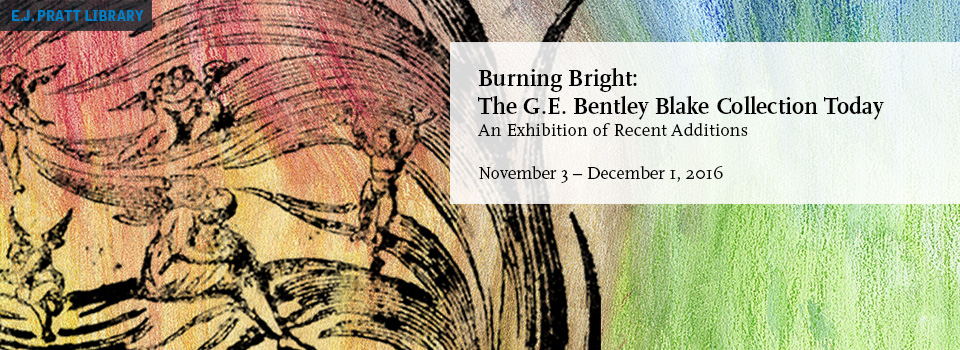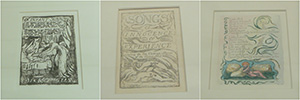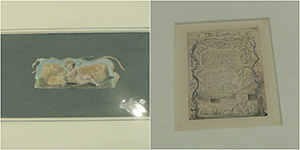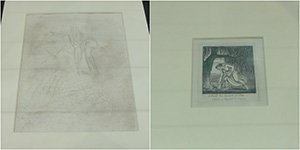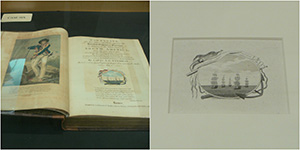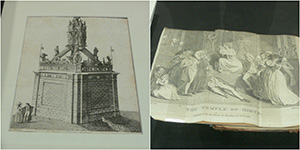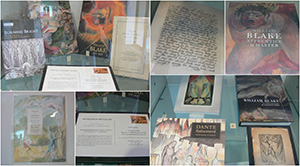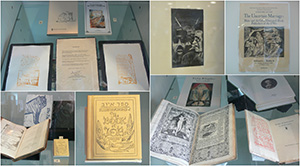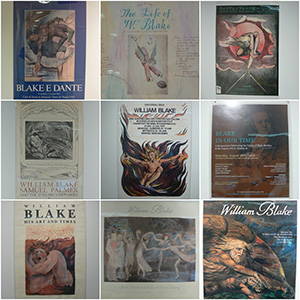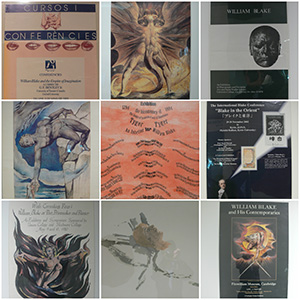Burning Bright: The Bentley Blake Collection Today
Burning Bright: The Bentley Blake Collection Today
An Exhibition of Recent Acquisitions
Victoria University Library
November 3 to December 1, 2016
Case 1: Songs of Innocence
William Blake (1757-1827). Songs of Innocence and of Experience: shewing the two contrary states of the human soul. Frederick Tatham, c.1832.
- Infant Sorrow (Plate 25)
- Songs of Innocence and of Experience Title Page (Plate 1)
- Little Girl Sweet and Small (Plate 22)
After Blake’s death in 1827, his widow Catherine went to live with the painter and engraver John Linnell and then with Blake’s friend Frederick Tatham. After Catherine’s death in 1831, Tatham reprinted the combined Songs with Blake’s copperplates and issued sets of the work with varying numbers of plates. These plates are referred to as copy I of Blake's Songs of Innocence and of Experience. (Bentley, Blake Books)
Case 2
- William Blake (1757-1827). Songs of Innocence and of Experience. Spring (Plate 23) 1789-94.
Etched in relief, color printed and hand coloured by Blake. Trimmed to the design only, it is 1 of only 3 plates from Innocence with colour printing. This is the only Blake etching known which has been cut along a design element, a vine, to create a decorative frame. Blake may have printed the 3 designs only, and masked the texts of these 3 plates as part of, or as an experiment, leading up to his Small Book of Designs of 1796.
- William Blake (1757-1827). Songs of Innocence. The Lamb (Plate 8) 1800-03.
Relief etching printed between 1800 -1803, somewhat unevenly in grayish-black ink and strengthened in “shell gold”, with extensive hand-colouring in watercolour. The plate is from copy Y (Bentley, Blake Books) of Songs of Innocence. Plates from this copy are unusual in being subtly highlighted throughout with what was referred to as "shell gold," a powdered gold leaf in a liquid suspension. In "The Lamb" the "shell gold" is evident in the corners and highlights the vine on the right-side of the plate and parts of the cottage roof.
Purchased with the assistance of The Friends of Victoria University Library.
Case 3
William Blake (1757-1827). Songs of Innocence. 1789-90.
- The Blossom (Plate 11)
- Songs of Innocence Title Page (Plate 3)
- A Dream (Plate 26)
The leaves are from copy W of Blake's Songs of Innocence, as listed in Bentley's Blake Books. It is believed to be the first printing, first issue of Blake's first extant attempt at illuminated printing. It is thought to have been printed in tandem with copy U (at the Houghton Library, Harvard) in 1789 by Blake with the help of his wife Catherine.
Case 4
William Blake (1757-1827). Songs of Innocence. 1789-90.
- A Cradle Song (Plates 16-17)
Purchased with assistance from the Friends of Victoria University Library and from a private donor.
Case 5
- William Blake (1757-1827). [An angel, arms upraised, with another figure]. 1819-25.
The drawing is from what is known as the Small Blake-Varley sketchbook. Inscribed on verso in the hand of John Varley "it is allways [sic] to keep yourself collected".
According to Blake’s first biographer, Alexander Gilchrist, visions of angels formed part of the experience of the young Blake who described seeing “angelic figures walking” in a field among workers as they gathered in the hay. Such visions remained with Blake as he grew older and are reflected in his work.
Purchased with the assistance of The Friends of Victoria University Library.
- William Blake (1757-1827). For the Sexes: The Gates of Paradise.
I found him beneath a tree by W. Blake (Plate 3). 17 May 1793 [possibly 1825].
Plate 3 is identified by G.E. Bentley as part of copy n. The incomplete set of plates from copy N are believed to have been printed during Blake’s lifetime. For the Sexes: The Gates of Paradise was an extensive revision of Blake’s For Children: The Gates of Paradise (1793) but was left unfinished at Blake’s death.
Case 6
- John Gabriel Stedman (1744-1797). Narrative of a Five Years' Expedition Against the Revolted Negroes of Surinam, in Guiana. London: J. Johnson, 1796.
The name of Blake (Mr. Wm.) London is on page [viii] in the list of "Subscribers Names".
- William Blake (1757-1827). Unpublished proof of an engraved vignette, oval device enclosing ships at sea, surround with anchor, cannon, flags and banner with motto 'cuncta mea mecum'. [1791].
A previously unrecorded engraving by William Blake of an original drawing by J. G. Stedman. In 1791, William Blake was commissioned to complete a number of engravings to accompany Stedman's Narrative. This vignette was designed for use on the title pages of Stedman's Narrative of a Five Years' Expedition Against the Revolted Negroes of Surinam in Guiana.
The vignette, as it appears in the book, varies in a number of ways from this print: an additional flag has been added to the mast of each ship, the clouds have been amended and Blake's signature was removed.
Acquired with the assistance of the Friends of Victoria University Library.
Case 7
- William Blake (1757-1827). Carfax Conduit. Oxford, [1787?].
- The Wit's Magazine, or, Library of Momus : being a compleat repository of mirth, humour, and entertainment. London, 1784-1785.
Each monthly number has a fold-out frontispiece illustrating one of the issue's articles or poems.
Plates in the first five numbers, and the item displayed, are engraved by William Blake.
Case 8: Early Studies and Biographical Material
- Bo Lindberg. [William Blake's workshop] [art original]
The artist's vision of what William Blake's studio would look like, open for the viewer to see what is taking place inside. A river is in the background. Superimposed in the sky is a reproduction of Blake's Job illustration for "When the morning Stars sang together & all the Sons of God shouted for joy" surrounded by a Blakean Sun. Produced by the artist for Beth & Jerry Bentley.
- Alexander Gilchrist (1828-1861). Life of William Blake: with selections from his poems and other writings. London: Macmillan, 1880.
Subtitled “Pictor Ignotus” (the unknown painter), Gilchrist’s biography, published thirty years after Blake’s death, was written with the intent to pull Blake’s art and writing out of obscurity.
Gift of Dr. Robert C. Brandeis.
- Frederick William Fairholt (1814-1866). Homes, Works, and Shrines of English Artists: with specimens of their styles: to which is added, Rambles in Rome. London: Virtue, 1873.
- Algernon Charles Swinburne (1837-1909). William Blake: a critical essay. London: J.C. Hotten, 1868.
- John Thurston (1774-1822). Religious Emblems: being a series of engravings on wood, executed by the first artists in that line, from designs drawn on the blocks themselves. London: T. Bensley, 1809.
Among the subscribers listed are William Blake, R.H. Cromek, John Flaxman and Henry Fuseli.
Case 9: Catalogues & Exhibitions
- Burning Bright: William Blake and the Art of the Book. Manchester: The John Rylands Library, University of Manchester, 2013.
- Cathy Leahy. William Blake. Melbourne, Victoria, Australia: National Gallery of Victoria, 2014.
- David Bindman. William Blake, 1757-1827: Imperial Stables, Prague Castle, 15. 9. - 19. 11. 2000. Prague: Published by Gallery for the Prague Castle Administration, 2000.
Exhibition created by Prague Castle Administration, The British Museum and The British Council.
- Ruthven Todd (1914-1978). Aspects of the Life and Work of William Blake : catalogue of an exhibition of drawings and books arranged by The British Council in the Fung Ping Shan Library, University of Hong Kong. Hong Kong, 1949.
- The William Blake Gallery from John Windle, Antiquarian Bookseller. “Announcing the first exhibition space dedicated to the iconic artist in over 200 years.”
Invitation to the opening on October 14, 2016.
- David Bindman. Dante Rediscovered: from Blake to Rodin. Grasmere, Cumbria: Wordsworth Trust, 2007.
A booklet published to accompany an exhibition held at the Wordsworth Trust, Dove Cottage, Grasmere from 15 August to 18 November 2007.
- David Bindman. Mind-forg'd Manacles : William Blake and slavery. London : Hayward Gallery, 2007.
- William Blake (1757-1827): le génie visionnaire du romantisme anglais. Sous la direction de Michael Phillips ; avec la collaboration de Catherine de Bourgoing. Paris : Petit Palais, Musée des Beaux-Arts de la Ville de Paris, 2009.
Victoria University Library contributed two items to this exhibition: London (Plate 46) of Songs of Innocence and of Experience and Song of Liberty (Plates 25-27) from copy M of The Marriage of Heaven and Hell.
- William Blake, an Exhibition. New York: Grolier Club, 1919.
Catalog of the exhibition held Dec. 5, 1919 - Jan. 10, 1920.
- Michael Phillips. William Blake : apprentice & master. Oxford : Ashmolean Museum, 2014.
The catalogue that accompanied an exhibition held at The Ashmolean Museum, Oxford, in 2014-15. Victoria University Library contributed Song of Liberty (Plates 25-27) from copy M of The Marriage of Heaven and Hell.
The catalogue is open to the inside cover to show copy M of The Marriage of Heaven and Hell, belonging to Victoria University Library’s Bentley Blake Collection.
Case 10: Editions of Blake’s works
- William Blake (1757-1827). Songs of Innocence and of Experience : shewing the two contrary states of the human soul. London: W. Pickering, 1839.
Victoria University Library copy is in contemporary binding with an original plate from the Songs as a frontispiece. The plate is no. 39, Introduction to Songs of Experience. It is a previously unrecorded posthumous impression in gray-black ink on wove paper without a watermark.
- William Blake (1757-1827). The Tyger. Second edition. London: Spoon Print Press, 2008.
All the images in this book made and printed by Linda Anne Landers at Spoon Print Press, London. Victoria University Library copy is number 5 of 20 signed and numbered copies.
- William Blake (1757-1827). London. London: The Strawberry Press, 1995. Wood-engravings by Paul W. Nash.
Victoria University Library copy is Paul Nash's inscribed presentation copy to Rod Cave.
- William Blake 1757-1827. Prose & Prophecy: selections from the prose and prophetic books of William Blake. New Hampshire: Hillside, 1964.
Victoria University Library copy is number 31 of 375 copies.
- William Blake (1757-1827). Songs of Innocence and of Experience : shewing the two contrary states of the human soul. Facsimile edition. Orlando, FLA: Flying Horse Editions, 2009.
"The copper plates ... were made by Michael Phillips from original William Blake impressions. The plates were inked, using hand mixed pure pigment, lead sulphate and stand oil, and printed by Dennis Ahearn at Flying Horse Editions. The paper was hand made by Gangolf Ulbricht."
"This facsimile edition is the first to produce examples from Blake's illuminated books as he made them, at every stage exactly emulating his method and materials" (from booklet accompanying the publication)
- William Blake (1757-1827). Eine Insel im Mond. Translated by Gernot Krämer and Jan Weinert with Illustrationen von Horst Hussel. An Island in the Moon in English and German. Berlin: Matthes & Seitz, 2007.
- William Blake (1757-1827). El Matrimonio del Cielo y el Infierno; translated by Fernando Castanedo. Marriage of Heaven and Hell in Spanish and English. Madrid: Cátedra, 2010.
- William Blake (1757-1827). Poetical Sketches. With decorations designed and cut on the wood by Charles Ricketts. London: Hacon & Ricketts, 1899.
- William Blake (1757-1827). Vaht' y Itaplari. Translated by Kaan H. Ökten. Selections in Turkish and English. İstanbul: P1"nhan, 2015.
- William Blake (1757-1827). Stikhi; translated with a commentary by A. M. Zverev. Selected verse in Russian and English. Moskva: "Progress", 1982.
- William Blake (1757-1827). Songs of Innocence. San Francisco: R. Thatcher and E. Grabhorn, 1924.
One of 100 copies printed by Ralph Thatcher and Ed Grabhorn.
Case 11: Secondary Studies
- Michael Farrell. Blake and the Methodists. Houndmills: Palgrave Macmillan, 2014.
- G.E. (Gerald Eades) Bentley, Jr. William Blake in the Desolate Market. Montreal: McGill-Queen's University Press, 2014.
- Michael Bédard. William Blake: the gates of paradise. Toronto: Tundra Books, 2006.
A presentation copy inscribed by the author to Victoria University Library.
- V.V (Vera Vladimirovna) Serdechnai͡a. Malye poėmy Uilʹi͡ama Bleika: povestvovanie, tipologii͡a, kontekst. Sankt-Peterburg: Dmitriĭ Bulanin, 2012.
- Noriko Kawasaki. [Eden wa Kita ka]: [William Blake Ronshu] On the Location of Eden: studies on William Blake. Tokyo : Kindai Bungeisha, 1996.
- Blake 2.0: William Blake in Twentieth-Century Art, Music and Culture. Edited by Steve Clark, Tristanne Connolly and Jason Whittaker. Houndmills: Palgrave Macmillan, 2012.
- Z. W. (Zbigniew William) Wolkowski. William Blake : the spirit and the letter: a chirographic and semiotic study of his quotations. Paris: Z.W. Wolkowski, 2014.
- Damon S. Foster (Samuel Foster) (1893-1971). A Blake Dictionary: the ideas and symbols of William Blake . Hanover, New Hampshire: Dartmouth College Press, 2013.
- Sexy Blake. Edited by Helen P. Bruder and Tristanne Connolly. Houndmills: Palgrave Macmillan, 2013.
- Irving Fiske. Bernard Shaw's Debt to William Blake; with foreword and notes by George Bernard Shaw. London: The Shaw Society, 1951.
- Diane Piccitto. Blake's Drama: theatre, performance and identity in the illuminated books. New York: Palgrave Macmillan, 2014.
- Roger Whitson. William Blake and the Digital Humanities : collaboration, participation, and social media. New York ; London : Routledge, 2013.
- Ben Watson. Blake in Cambridge or 'The Opposite of David Willetts': how Blake's vortex anticipated so much we might call his books 'prophetic'. London: Unkant Publishers, 2012.
- Eugene Stelzig. Bob Dylan's Career as a Blakean Visionary and Romantic. New York: Milne Library, State University of New York at Geneseo, 2013
Case 12: Inspired by Blake
- William Bell Scott, (1811-1890). [Portrait of William Blake] [art reproduction] / etched by W.B.S. from the picture now in the possession of H. Buxton Forman, Exhibited in the Burlington Club Blake Ex. 1876. London : Published by P. & D. Colnaghi & Co., 13 & 14 Pall Mall, East, Octr. 15th, 1881. [digitized image].
- Evelyn Morchard Bishop. The Star Called Wormwood: an investigation of the possible reasons for its decline and fall as described in the VIIIth chapter of the Apocalypse. London: Victor Gollancz Ltd, 1941
- Marcus Sedgwick. Dark Satanic Mills. London: Walker Books Ltd, 2013.
- C. Jeré. Bronze Desk Statue of William Blake. California, '70 [i.e. 1970].
- John Rowe Townsend. Forest of the Night ; illustrated by Beverly Brodsky McDermott. Philadelphia: J. B. Lippincott Company, 1975.
An allegorical interpretation of William Blake's poem "The Tyger."
Victoria University Library copy is signed on the title page by the author. - Jack Shepherd. In Lambeth : a play. London: Methuen Drama, 1990.
- William Blake. [Australia] : [Stamina Clothing Company], [between 1946 and 1966]. 2 advertising cards.
- Yvette de La Frémondière. William Blake 1757 – 1827. France, 1972. Pewter plated copper medal.
- Jack Beeching. William Blake - 200 years. Twinstead Green, Sudbury, Suffolk: The Myriad Press, [1957?].
A folded leaflet celebrating the 200th anniversary of William Blake's birth; it consists of five poems by various authors and a wood engraving by Peter Dunbar.
- Allen Ginsberg (1926-1997). Your Reason & Blake's System. New York: Hanuman Books, 1992.
- James John Garth Wilkinson (1812-1899). Improvisations from the Spirit. London: W. White, 1857.
- William Blake (1757-1827). Songs of Innocence; music and illustrations by Ellen Raskin ; guitar arrangement by Dick Weissman. New York : Doubleday, 1966.
- Ed. Buryn. The William Blake Tarot of the Creative Imagination. Nevada City, CA: Published by T.A.R.O.T. [i.e. Tools and Rites of Transformation], 2010.
- Jah Wobble. The Inspiration of William Blake. London : 30 Hertz/Thirsty Ear/All Saints, 1997.
- Blake: the marriage of heaven and hell; produced by The Media Group for the Swedenborg Foundation ; writers, Harvey F. Bellin, Tom Kieffer. New York: Swedenborg Foundation, c1984.
- Pioneers of the Spirit: William Blake. New York : Trinity Television, the Parish of Trinity Church, 1999.
- Fernand Pena. Ode to William Blake: rock songs with words from the mind. Paris, LéZarts, 2010.
Please see the South Wall of the Library for the
Bentley Blake Collection of posters on display.
Sources and Credits
G.E. Bentley, Jr. Blake Books. Oxford: Clarendon Press, 1977.
William Blake (1757-1827). Songs of Innocence and of Experience: shewing the two contrary states of the human soul. Facsimile edition. Orlando, FLA: Flying Horse Press, 2009. (Booklet accompanying publication).
Alexander Gilchrist. Life of William Blake. London: Macmillan, 1880.
Organized by Carmen Socknat and Lisa Sherlock with the assistance of Erin Siegel, Paul Wilson, Abe Lam, Sarah Gough and Halyna Kozar.
 Ask Us
Ask Us